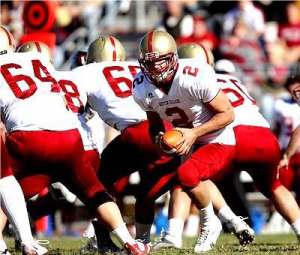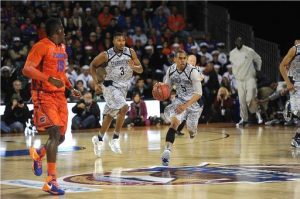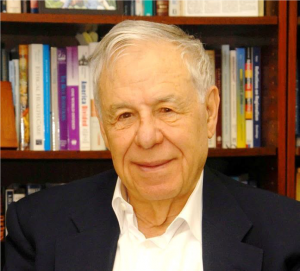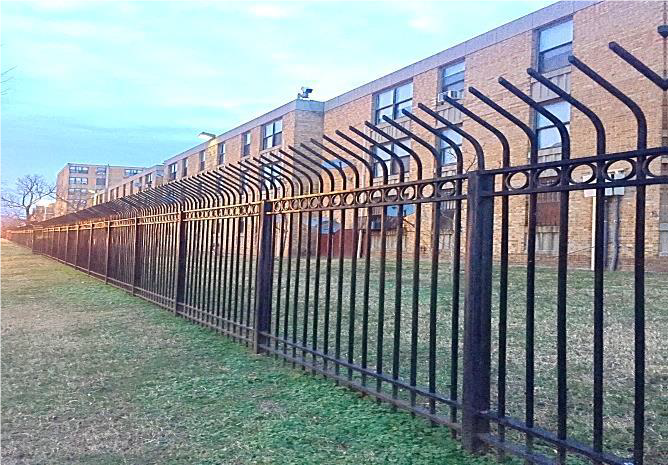By J.L. Johnson
Friday Night Lights
In 1988, George H. W. Bush emerged from a private plane in Odessa for what would be his only visit to the small Texas city during his presidential campaign. Addressing the crowd assembled at the airfield, the elder Bush relayed his love and admiration for Texas football. He reminded the assembly that he had lived in the area for the last eight years, during which time he attended a Permian Panthers high school football game for one fluorescently lit Friday night.
Now Bush is asking the Texans in the crowd for their vote, seamlessly weaving into his stump speech the vocabulary of football, linking community and traditional values to those deeply felt codes of pride and competition ritualistically enacted when the Panthers take the field. In 1988, the city of Odessa overwhelmingly voted for George H. W. Bush, on his way to becoming the 41st President of the United States.
Tuesday Night Primaries
On February 9, 2016, Greg Popovich, affectionately known as Pop, the basketball genius (responsible for another legendary Texan sports dynasty in the San Antonio Spurs), resembling a curmudgeon grandfather with thinning white hair and a matching wizened beard, exited his locker room and sidled up to a television broadcaster for his live halftime interview. The National Basketball Association’s (NBA) media partnerships include the contractual obligation that head coaches answer questions from reporters during nationally televised games, a sacrificial offering of access to televisual corporations anxious for new content. Pop famously despises the arrangement. He almost never answers more than the mandatory two questions and only offers curt answers. But his interview on the Tuesday night of the 2016 New Hampshire presidential primaries was a little different. Receiving a cue from television producers, the broadcaster asked Popovich about his struggles against the Miami Heat. “Thanks again guys. Pop, your impression of the first quarter?”
Pop says, “We’re behind and they’re ahead.”
“Why is that?”
“They scored more points than we did. We were pretty crappy on defense. It’s been fun.”
Broadcasters know Popovich views them as trivial marketing ploys, and so this broadcaster gamely laughs. Pop smirks, pivoting on his left heel and taking a few quick steps toward his sideline. Then something extraordinary occurs. The broadcaster halts Pop’s brusque walk by asking him, “Do you want election results?”
Pop is confused at first, but then the corners of his upturned lips flatten. He steps back into the microphone, asking, “Who is it?”
“It’s Sanders and uh, Trump.”
Pop frowns. His bottom lip drops. The smile in his eyes deteriorates into a bleak incredulity. He stares for a few seconds, sighs. It seemed like he has something to say, but then Pop’s shoulders sag, he shakes his head, his eyes drop to the hardwood, and he turns around and slouches to his sideline.
Whether the Sanders or Trump primary victory dismayed Popovich was impossible to tell from the interaction. Close followers of the Spurs, like basketball fans more generally, might guess it was not Sanders. Though basketball and football are often lumped together with baseball as the Big Three popular major sports in America, football and basketball are arguably worlds apart. Basketball and football are at the center of two differently shaped galaxies, at times conditioning and at other times reinforcing diverging sets of moral and political schema and basic categories of thought about things social.
Is Greg Popovich the NBA’s Bill Belichick?
Pop’s stoicism resembles the quiet moodiness of Bill Belichick, the head coach of the National Football League’s (NFL) New England Patriots. But claiming Belichick as Popovich’s counterpart in the NFL would be inaccurate. Belichick seems to experience the pain of mandatory communications for different reasons than Pop.
If Popovich is your curmudgeon grandfather who nonetheless believes in the sanctity of his sport, Belichick is your uncommunicative shady uncle. To Belichick, transparency is weakness. Secrecy is strategic advantage. In accounting for Belichick’s four NFL championships over the last seventeen years, we would need to reckon with more than his coaching and the quality of the play on the field.
Some manipulation and backstage nefariousness have certainly been factors, embroiling Belichick’s teams, particularly his star quarterback Tom Brady, in no fewer than two publicly verified cheating scandals.
Over the same timespan that New England has led the NFL in championships, Popovich’s San Antonio Spurs have led the NBA in most championships won, tied with the Los Angeles Lakers. But Pop’s controversies consist of mild league annoyances; for example, he opts to rest his star players throughout the season, even during nationally televised marquee match-ups. Much like his aversion to marketing ploys, Pop opts to do what is best for the health of his players and what increases their chances at having success during the playoffs, resting players strategically yet transparently.
Another key difference lies in the racial makeup of Pop and Belichick’s teams. Pop’s teams certainly do not resemble Belichick’s teams in terms of nationality and ethnicity. The three best players during the San Antonio Spurs’ championship era have been Tim Duncan, a center from the Virgin Islands, Manu Ginóbili, a forward from Argentina, and Tony Parker, a point guard from France. With a record number of global players joining the roster, the Spurs paradoxically have been the United Nations (UN) of the NBA. I say paradoxical because the team’s Texan fan base, whatever of it exists, is likelier than not to distrust the cosmopolitanism and global institutionalism represented by the Spurs and the UN alike.
It’s not as though the NFL has not reached for global participation. The NFL has recently made a concerted effort, with minimal success, at exporting its sport to a global audience, most obviously by staging games in England. Without similarly concerted effort, basketball has been the better loved American sport abroad. Professional basketball leagues exist in all major European states, in China, and in many South American countries. Of America’s three most popular sports, the Olympics include only basketball. Onshore, football may be supplanting baseball as America’s favorite pastime, but it does so provincially and, at some tacit level, somewhat arrogantly. Outside the U.S., folks put “football” in quotation marks or qualify it as American.
The context of Belichick’s stoicism, unlike Pop, is parochial. The New England Patriots are no cosmopolitan outfit. Belichick’s sport is populist. His secretive ways are celebrated. His reign consists of viewing rules as things to be massaged, bent, or broken, if certain results are desired. Not a cheater, the white superstar quarterback Tom Brady is All-American.
Differences of Race and Control in Football and Basketball
Dwelling on the differences in how football and basketball are played may seem trivial, but I want to say that those gaps in the architecture of the games reveal much about today’s gulf in American thought on race and politics. Basketball places far fewer players on the court, and each basketball player is responsible for both offense and defense.
A football team resembles a modern corporation. There is a pronounced division of labor. Within a football team are more teams, offense, defense, and special teams. Within those separate teams are highly specialized units, each with its own unique skillset. Wide receivers are much smaller and faster than offensive linemen. Offensive linemen, stronger and gargantuan, protect the interior.

Source: pixabay.com
Émile Durkheim had something in mind like the modern structure of a football team when he argued that modern societies, in all their complexities and, especially, in their differences by race and class, would become bound by solidarity despite increasingly specialized, separate, and dependent units, because the mystifying work of the whole is what enables modern success.
But the different structures of American football and basketball tell a different story about race and solidarity in America, one that sadly is more about power over racial divisions.
While a lot of careful thought goes into the structure of a basketball contest, a game looks to casual fans like barely organized chaos. Basketball has been likened to jazz, but here I want to emphasize basketball as participatory democracy. Every player on the court will touch the ball often during a contest, and games occur frequently, three or four times a week. Although the coach develops and calls plays, the point guard exercises extraordinary discretion in changing the play or choosing an unscripted move toward the basket, to which teammates will react and improvise their play. Increasingly, all players might take the role of the point guard at some point during the game.

Source: pixabay.com
Forwards like LeBron James, or legend Magic Johnson assume some of the duties of a point guard during gameplay. Even more complicated, in today’s game, seven-foot centers make three point baskets. Football’s division of labor unfurls like a liberal democracy. Players might interact with coaches throughout the week, voicing concerns or offering feedback. Meetings are held, plans are worked out, but coaches take control on game day.
When your favorite team’s offense goes on the field, you can trace a chain of command. A play gets called by the coach. Your quarterback huddles up the offensive units. Your team’s offense fans out, runs a play, stops to take stock. Attention is fixed on the quarterback, the head coach’s chosen representative, who takes possession, moves the players downfield, and seemingly leads the team to victory or defeat.
Two Quarterbacks
A year before Tom Brady was drafted by the New England Patriots, the Philadelphia Eagles selected Donovan McNabb second in the 1999 NFL draft, making him at the time the highest-drafted African-American quarterback in NFL history. Philadelphia fans attending the draft responded by booing McNabb. Claims that such a reaction was overtly racist were rejected by counterclaims that the jeers were caused by a fervent preference for Ricky Williams, the best college running back in 1998.
But not enough has been admitted about Rush Limbaugh and Curt Schilling, two provocateurs beloved by listeners of right-wing radio, who were implying on-air what many white Philadelphians were undoubtedly saying privately. Black men can’t play quarterback. They aren’t intelligent or responsible enough to be leaders. It was a combination of Philly’s infamous sports incivility, a preference for a running back, race-based assumptions about the quarterback position, and the control of black bodies. Fans saw themselves as corporate stockholders with power over who gets drafted; running backs are likelier than quarterbacks to be black; and Donovan McNabb, the first African-American quarterback to be chosen as the immediate face and future of an NFL franchise, was publicly rejected.
Measured by wins, division championships, and individual statistics, McNabb proceeded to become the best quarterback in Philadelphia’s franchise history, joining an elite company of only four NFL quarterbacks to pass for more than 30,000 yards and run for more than 3,000 yards in their careers. In 2004, McNabb steered the Eagles to an NFL championship game. McNabb’s Eagles lost to Belichick and Brady’s New England Patriots, costing McNabb his one chance to earn consensus as a future Hall of Famer. As it stands, sports writers debate whether McNabb should be enshrined at all. Too many Philadelphia fans and writers wrongly experienced the loss as McNabb’s personal failure. A second public rejection ensued. Despite football’s corporate structure as a team game and the multiple factors in any loss, Brady and McNabb were juxtaposed in black and white. Brady was the better quarterback. Brady possessed the truer skills to lead a team. McNabb ran too much and made poor decisions. Brady knew how to make a team great. McNabb was a loser.
The disproportionate handwringing over McNabb’s performance concurred with Philadelphia’s embrace of the basketball superstar Allen Iverson. Jeering McNabb while cheering Iverson made sense only if one considers the different racial codes of morality and politics at play in their respective sports. Those audiences listening to right-wing radio dismissals of McNabb also heard that the NBA was out of control, yet, unlike football, professional basketball seemed to be yielded to Black America and its cosmopolitan, global, and youth allies. Iverson and the new era of basketball could be celebrated on their own terms, a celebration of a small victory in the 1990s culture war over race. Iverson was simply the stamp on the NBA as hip-hop, authentic, genuine, and urban.
Surely, this is all way too simple. With more time, we could detail the more complicated race tensions around NFL quarterbacks and Allen Iverson alike. We could further discuss the incorrectness of a common lament that Iverson caused too much one-on-one basketball, often code for undisciplined and out of control black behavior.
Iverson innovated some of the most complicated offensive sets of screen-and-rolls and cuts, but the point is that the ways of framing black professional athletes and their professional leagues, and responding to their moments of success and failure have been diverging since the 1990s.
Obviously, both sports employ white and black athletes, but there are far more white athletes in the NFL, and while a record number of African-American quarterbacks started in 2016, the quarterback position continues to be white-dominant. And given the quarterback position’s disproportionate status in the outcomes of contests, by extension, the game of football is imagined to be under white control. For example, the criticism against Cam Newton, the first black quarterback to be selected outright as the NFL’s most valuable player in 2015, was that he wasn’t a “true” quarterback because he ran too much and danced after touchdowns.
The absurd controversy over the ascent of Newton, and especially his signature move, the Dab, evinces how whites continue to view a black quarterback: too flashy, arrogant, doesn’t play the game right, makes poor decisions, and, unlike Tom Brady, cannot win consistently.
Black Lives Matter Protests in the NFL and NBA
The divergent framings of black athletes in basketball and football are reflected in our talk about race and politics, and for some of us, it may influence how we make decisions in a democracy. The NBA has been a crucial site of movement visibility for Black Lives Matter (BLM), and LeBron James has been one of BLM’s most outspoken supporters. Like White America’s reaction to Cam Newton’s MVP selection, white feelings of loss of control were belied when, in 2010, James left Cleveland for Miami as a free agent. A survey1 at the time found that whites were much likelier than blacks to express anger at James’ decision. James has extended his freedom of thought and action to speaking out on social issues.
He has organized boycotts of mandatory warm-up suits, leading teammates in shows of solidarity with BLM. After Travon Martin’s murder, for example, James and the Miami Heat wore black hoodies like the one worn by Martin on the night he was killed by a vigilante.
For a few weeks, a network of NBA superstars threatened to boycott games if the league did not speak out against the shootings of unarmed black men. For their part, NBA owners, managers, and coaches have mostly cooperated in a tacit alignment with BLM, as well as socially progressive issues more broadly.
The NFL’s division of labor has structured social protest differently. There have been fewer signs of team solidarity. Instead, different individuals, in consultation with their teammates and coaches, have chosen smaller acts of collective alignment with BLM.
At the beginning of the NFL season, for example, Colin Kaepernick began kneeling during the national anthem to protest police brutality and extrajudicial killings of black men. Kaepernick, an African-American quarterback, was supported by his teammates, but his actions angered many Republican and socially conservative fans. That such disapproval of football players has gained significant traction relates to the fact that the team, as a metaphorical corporation, does not unite in shows of solidarity. At most, a handful of athletes kneel or hold up fists in a sign of Black Power and solidarity, and these athletes tend to know each other from their specialized units of play.
The 2016 NBA and NFL seasons and their different moments of racial politics coincided with the 2016 Presidential Election. On September 28, 2016, Bill O’Reilly, a pundit on Fox News (the cable channel preferred by most Republicans and many social conservatives) casuistically asked the Republican Party’s nominee what he thought about a BLM protest in the NFL. O’Reilly asked, “Last night Colin Kaepernick said another bad thing about his country. You did own a professional football team. What would you do with Collin Kaepernick?”
Donald Trump staked his campaign on his billionaire status, promising Americans that he could pivot from his prowess as a multinational real estate tycoon and his donor status in America’s political system. Trump said, “I think what he’s doing is disgraceful. Is he starting yet or is he still a second-string quarterback?”
“Second-string,” O’Reilly assured him, “But what do you do to him if you were the owner? What would you do?”
At his campaign events, Trump told mostly white and working class audiences that America was out of control. Cosmopolitans and global elites were endangering their lives, and only he was the law and order candidate able to restore America to its proper greatness. Trump said to O’Reilly, “He’s making a tremendous amount of money. He’s living the American dream. He’s trying to make a point. But I don’t think he is making it the correct way. Personally, if it was me, I would not be happy if I were the team owner, and I don’t think I’m going to tell you what I would do…”
Trump is a real estate mogul who became a reality television star. In his televised competition shows, he would use a catchphrase, “You’re fired.” He would spit this at the end of a show to the contestant who had lost that week’s episode. O’Reilly asked, “Would you fire him?”
“I wouldn’t be happy,” Trump said, “They are paying him all of this money. And I think what he is doing is very bad for the spirit of the country. At the same time, he has the right to protest and that’s one of the beautiful things about the country.”
During the campaign, Trump framed himself as the one candidate able to sort out the winners from the losers in America and make the country and economy what his supporters want. His political career essentially began as a publicity stunt to remove the first African-American President from office on the fabricated charge that he was not a real U.S. citizen. At campaign events, Trump has called Mexicans rapists and killers and black protesters losers, the people who are not making America great.
O’Reilly pressed Trump, “But does he have the right to protest on your dime? Say you’re the owner. It’s your stadium. It’s paying customers. It’s your dime. This is right in your bailiwick. OK? So he’s protesting on your dime doing something that offends you. Would you take action against him?”
“I’ll tell you. Offends me, it does,” Trump answered in characteristic fragments, “Especially since he’s doing so well in terms of economically and so many other ways. I guess he probably lost a starting position because something happened to him. He went downhill fast. And, frankly, that’s okay. But I would not be a happy camper.”
On November 7, 2016, the night before the general election, Trump emerged from his gilded jet and addressed a crowd in New Hampshire’s biggest city, Manchester. Trump bellowed about the New England Patriots’ quarterback, known to be a good friend and Trump’s frequent golfing partner. Trump told the crowd, “Tom Brady called today, he said, Donald, I support you, you’re my friend, and I voted for you.” Trump added that the Patriots’ head coach, Bill Belichick, sent him an endorsement letter. Trump quoted Belichick, “Congratulations on a tremendous campaign. You have dealt with an unbelievable slanted and negative media, and have come out beautifully.” By reading Belichick’s endorsement, Trump seamlessly incorporated into his stump speech Belichick’s unapologetic winning ways, his ruthless secrecy, his sullen tenacity in producing championships, generating in the New England area a defensive team pride in the winningest NFL team of the past fifteen years.
Trump continued by quoting Belichick, “You’ve proved to be the ultimate competitor and fighter. Your leadership is amazing. I have always had tremendous respect for you, but the toughness and perseverance you have displayed over the past year is remarkable. Hopefully tomorrow’s election results will give the opportunity to make America great again.” Trump successfully drew a chain of command from himself, to New England’s head coach, along to its star white quarterback, positioning himself atop and in control of a chain of command that many white football fans prefer to see every Sunday. Trump lost New Hampshire by the slimmest of margins, but he won Manchester on his way to becoming the 45th President of the United States.
Coda
The Friday after the election, Greg Popovich took his seat for a pregame press conference. His ensuing comments revealed what was most likely going through his mind that night in February. On Trump, Pop said, “He is in charge of our country. That’s disgusting.” There was a silence in the room. Then, uncharacteristically, Popovich expounded at length. “I’m a rich white guy and I’m sick to my stomach thinking about it. I can’t imagine being a Muslim right now or a woman or an African-American, Hispanic, a handicapped person. How disenfranchised they might feel. For anyone in those groups that voted for him, it’s just beyond my comprehension how they ignore all that.”
Pop clarified, “Not basically because the Republicans won or anything, but the disgusting tenure and tone and all the comments that have been xenophobic, homophobic, racist, misogynistic. I live in that country where half the people ignored all that to elect someone [like that]. That’s the scariest part of the whole thing to me.” Pop shook his head, fielded a few more questions, and departed to play the Detroit Pistons.
Notes
1. http://espnmediazone.com/
Return to January 2017 Issue








